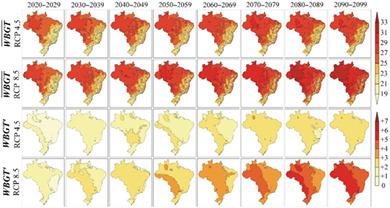当前位置:
X-MOL 学术
›
Int. J. Climatol.
›
论文详情
Our official English website, www.x-mol.net, welcomes your
feedback! (Note: you will need to create a separate account there.)
Climate change impacts on heat stress in Brazil—Past, present, and future implications for occupational heat exposure
International Journal of Climatology ( IF 3.5 ) Pub Date : 2020-10-09 , DOI: 10.1002/joc.6877 Daniel Pires Bitencourt 1 , Lincoln Alves 2 , Elisa Kayo Shibuya 3 , Irlon da Cunha 3 , João Paulo de Souza 2, 4
International Journal of Climatology ( IF 3.5 ) Pub Date : 2020-10-09 , DOI: 10.1002/joc.6877 Daniel Pires Bitencourt 1 , Lincoln Alves 2 , Elisa Kayo Shibuya 3 , Irlon da Cunha 3 , João Paulo de Souza 2, 4
Affiliation

|
Climate change has caused an increased occurrence of heat waves. As a result of rising temperatures, implications for health and the environment have been more frequently reported. Outdoor labour activities deserve special attention, as is the case with agricultural and construction workers exposed to extreme weather conditions, including intense heat. This paper presents an overview of heat stress conditions in Brazil from 1961 to 2010. It also presents computer‐simulated projections of heat stress conditions up to the late 21st century. The proposed climate analysis drew on historical weather data obtained from national weather stations and on reanalysis data, in addition to future projections with the ETA (regarding the model's unique vertical coordinate) regional forecast model. The projections took into consideration two Representative Concentration Pathways (RCP)—the 4.5 and 8.5 climate scenarios, namely, moderate and high emissions scenarios, respectively. Heat stress was inferred based on the wet‐bulb globe temperature (WBGT) index. The results of this climate analysis show that Brazilian outdoor workers have been exposed to an increasing level of heat stress. These results suggest that future changes in the regional climate may increase the probability of heat stress situations in the next decades, with expectations of WBGT values greater than those observed in the baseline period (1961–1990). In terms of spatial distribution, the Brazilian western and northern regions experienced more critical heat stress conditions with higher WBGT values. As a response to the increased frequency trends of hot periods in tropical areas, urgent measures should be taken to review public policies in Brazil. Such policies should include actions towards better working conditions, technological development to improve outdoor labour activities, and employment legislation reviews to mitigate heat impacts on occupational health.
中文翻译:

气候变化对巴西热应激的影响-职业热暴露的过去,现在和将来的影响
气候变化导致热浪增加。由于气温上升,对健康和环境的影响更为频繁地被报道。户外劳动活动值得特别注意,农业和建筑工人要暴露在极端天气条件下,包括高温。本文概述了1961年至2010年巴西的热应激条件。它还提供了计算机模拟的直至21世纪后期的热应激条件预测。拟议的气候分析借鉴了从国家气象站获得的历史天气数据以及再分析数据,此外还考虑了未来的ETA预测(关于模型的独特垂直坐标)。)区域预测模型。这些预测考虑了两个代表性的集中途径(RCP),即4.5和8.5气候情景,分别是中度和高排放情景。根据湿球温度(WBGT)指数推断热应力。气候分析的结果表明,巴西的户外工人暴露于不断增加的热压力之下。这些结果表明,根据WBGT的预期,未来几十年区域气候的变化可能会增加热应激状况的可能性。该值大于基线期(1961-1990年)观察到的值。在空间分布方面,巴西西部和北部地区遭受的热应力条件更为苛刻,WBGT值较高。为了应对热带地区炎热季节频率增加的趋势,应采取紧急措施来审查巴西的公共政策。此类政策应包括为改善工作条件采取的行动,为改善户外劳动活动而进行的技术开发以及为减轻热量对职业健康的影响而进行的就业立法审查。
更新日期:2020-10-09
中文翻译:

气候变化对巴西热应激的影响-职业热暴露的过去,现在和将来的影响
气候变化导致热浪增加。由于气温上升,对健康和环境的影响更为频繁地被报道。户外劳动活动值得特别注意,农业和建筑工人要暴露在极端天气条件下,包括高温。本文概述了1961年至2010年巴西的热应激条件。它还提供了计算机模拟的直至21世纪后期的热应激条件预测。拟议的气候分析借鉴了从国家气象站获得的历史天气数据以及再分析数据,此外还考虑了未来的ETA预测(关于模型的独特垂直坐标)。)区域预测模型。这些预测考虑了两个代表性的集中途径(RCP),即4.5和8.5气候情景,分别是中度和高排放情景。根据湿球温度(WBGT)指数推断热应力。气候分析的结果表明,巴西的户外工人暴露于不断增加的热压力之下。这些结果表明,根据WBGT的预期,未来几十年区域气候的变化可能会增加热应激状况的可能性。该值大于基线期(1961-1990年)观察到的值。在空间分布方面,巴西西部和北部地区遭受的热应力条件更为苛刻,WBGT值较高。为了应对热带地区炎热季节频率增加的趋势,应采取紧急措施来审查巴西的公共政策。此类政策应包括为改善工作条件采取的行动,为改善户外劳动活动而进行的技术开发以及为减轻热量对职业健康的影响而进行的就业立法审查。











































 京公网安备 11010802027423号
京公网安备 11010802027423号